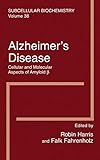Alzheimer’s Disease : Cellular and Molecular Aspects of Amyloid ? / edited by J. Robin Harris, Falk Fahrenholz.
Tipo de material: TextoSeries Subcellular Biochemistry ; 38Editor: Boston, MA : Springer US, 2005Descripción: XVII, 409 páginas, recurso en líneaTipo de contenido:
TextoSeries Subcellular Biochemistry ; 38Editor: Boston, MA : Springer US, 2005Descripción: XVII, 409 páginas, recurso en líneaTipo de contenido: - texto
- computadora
- recurso en línea
- 9780387232263
- QH345
Springer eBooks
The Contribution of Microscopy to the Study of Alzheimer’s Disease, Amyloid Plaques and A? Fibrillogenesis -- Transgenic Mouse Models for APP Processing and Alzheimer’s Disease: Early and Late Defects -- Oxidative stress in Alzheimer’s Disease: Implications for Prevention and Therapy -- ?-Secretase, APP and A? in Alzheimer’s Disease -- The Non-Amyloidogenic Pathway: Structure and Function of ?-Secretases -- Amyloid ? Degradation: A Challenging Task for Brain Peptidases -- The Protective Role of Vitamin E in Vascular Amyloid ?-Mediated Damage -- Amyloid Accumulation and Pathogensis of Alzheimer’s Disease: Significance of Monomeric, Oligomeric and Fibrillar A? -- Cholesterol and Amyloid ? Fibrillogenesis -- Alzheimer’s ?-Amyloid: Insights into Fibril Formation and Structure from Congo Red Binding -- The Aluminium-Amyloid Cascade Hypothesis and Alzheimer’s Disease -- Amyloid-? Metal Interaction and Metal Chelation -- The Interaction of Amyloid-? with ApoE -- Clusterin and Alzheimer’s Disease -- Acetylcholinesterase Interaction with Alzheimer Amyloid ? -- Membrane Disordering Effects of ?-Amyloid Peptides -- The Role of Alzheimer A? Peptides in Ion Transport Across Cell Membranes -- Amyloid Inhibitors and ?-Sheet Breakers -- Cholesterol and Alzheimer’s Disease: Statins, Cholesterol Depletion in APP Processing and A? Generation -- Phosphorylated Amyloid-?: the Toxic Intermediate in Alzheimer’s Disease Neurodegeneration.
This book contains a survey of present-day research into the biomedical fundamentals of Alzheimer’s disease (AD). It contains 20 chapters dealing with widely ranging topics, all of which have a bearing upon the understanding and treatment of AD. Starting with a broad survey of the contribution that the various microscopical techniques (light microscopy, electron microscopy, atomic force microscopy) have made since the seminal light microscopical studies of Alois Alzheimer, the book presents chapters on specialist topics:- transgenic mouse models of AD; the enzymology of amyloid-ß production and degradation; oxidant stress and antioxidant protection; the involvement of metal ions and the influence of chelators; the importance of amyloid-ß oligomers and fibrils, the role of cholesterol in their formation and characteristic binding of the dye Congo red; of the many AD plaque-associated proteins, ApoE4 , clusterin and acetylcholinesterase receive individual attention; the effect of amyloid-ß on neuronal membrane calcium channels and membrane fluidity are covered, as are drug interactions, the ß-sheet breaking peptides and the statins that may prevent oligomer/fibril formation in AD; the possible significance of amyloid-ß phosphorylation receives detailed attention. Overall, the book contains a broad range of current information on cellular, biochemical and structural aspects of amyloid-ß, of direct relevance to Alzheimer’s disease.
Para consulta fuera de la UANL se requiere clave de acceso remoto.


